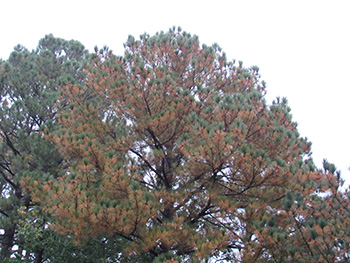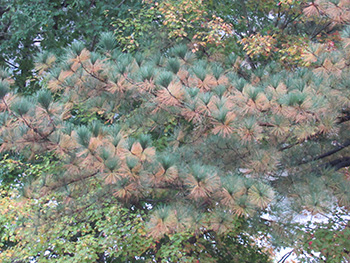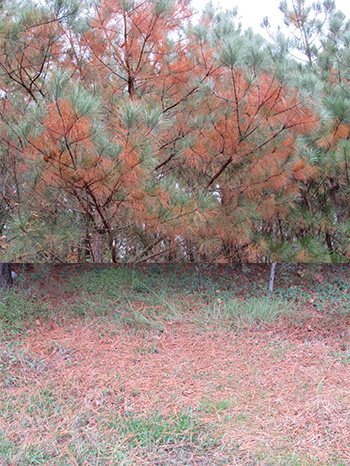Needleless to Say, It Does Look Strange
Needleless to Say, It Does Look Strange
By Bill Willis and Bill Steinmetz


December, 2018
- Pine Trees in North Carolina are considered conifer (cone) evergreens
- A pine needle is a short branch with from two to five long needle-like leaves
- It is normal for North Carolina pines to shed needles in the fall
- Needle browning at other times during the year may be cause for alarm
Trees can be grouped into two categories: evergreen (retaining leaves year-round) or deciduous (losing leaves) in the fall. Within the evergreens are the conifers like the pines. These trees can and do lose some of their green foliage each year, but not all needles. The fact that needles persist multiple years make the trees evergreens. Old needles drop and then new needles are added at the branch tips, thereby overlapping the two processes and making the limb longer. The degree of loss can vary depending on the species, growing conditions, the prevailing climate, and possible disease. Normal needle retention could be two to five years, Eastern White Pine and Spruce respectively. The amount of browning appears greater than usual this year. This could indicate that the needles produced in that earlier year were above average, so that the loss now appears greater when they do turn color and drop.
Pines shed older needles in the fall and the amount of loss can be significant on a healthy large tree without incurring detrimental effects. If the young needles at the tips of the branches remain green, the tree is usually in good shape. Not all the same type pines will show the same degree of shedding, so observe over time.

Even deciduous trees like the oaks and maples will often retain some of their leaves going into the winter season, so there may be variations in both categories.
If pine needles are lost at other times of the year, it would be important to learn why, for drops during periods other than fall or due to physical damage are rare. Consider when the brown needles occur.
Spring loss may be due to weather, poor nutrition, water stress, infections or insects. Late summer loss may be due to Dosthristroma needle blight (needles appears banded). Summer or fall, progressing into spring may be due to pine wilt disease caused by a nematode worm and spread by the pine sawyer beetle.
Whenever major browning and needle drop occurs at times other than fall, check with the Agricultural Extension Service or your local arborist.
Some of these pine problems manifest themselves quickly and become contagious if not addressed properly. The finding that NIEHS has pockets of dead trees on campus led to aerial surveillance and mapping of locations for further evaluation and possible treatment. Loblolly pines behind the Lakeview Drive wildflower meadow and at the intersection of the Lakeview Drive Pedestrian Walking Trail and Memorial Garden Trail have been recently added to list of pine decline.



